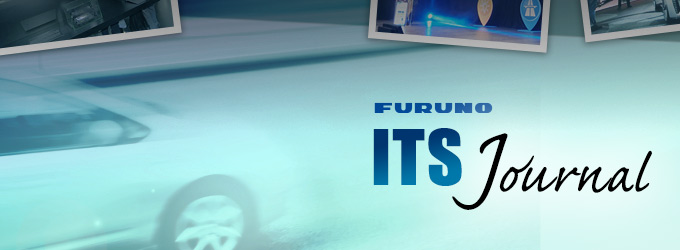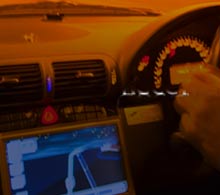Articles for ITS market ITS EU 2017 Field Reports -Automatic Operation and the eCall-
The 12th ITS EU 2017 conference was held in a capital of LRT (Light Rail Transit) in hot weather
In late June, the 12th ITS EU 2017 conference was held in Strasbourg city in eastern France.
“ITS” is the Intelligent Transport Systems. The ITS worldwide conference where all countries of the world meet is held every two years, but the ITS EU is held in the off year when the ITS worldwide conference is not held in Europe.
The name is “the ITS EU 2017”, but the world automobile industry is being led by Europe companies such as the German 3 (Daimler, BMW, VW) as well as (Bosch, Continental) and parts manufacturers, and that is why about 3000 people from all over the world including Japanese companies participated to explore the latest trend of the industries.
Speaking of Strasbourg as a venue, it is world famous for its success in compact city policy, utilizing the next generation type of tramway LRT for urban transportation. This time I stayed for a week and purchased a one-day pass ticket of LRT for 4.5 euros. It was very helpful, for example I took the LRT from the hotel area to the venue, from Strasbourg Central Station to the city center and so on. However, during my stay, unusual heat waves are flowing in Europe, and it is extremely hot so that the outdoor temperature reached 35 degrees even at 7 pm, the air conditioner in LRT was weak at cooling, and I could not get comfortable.
Automated driving is spreading in many European countries.
Even in the ITS EU, the main topic was still automated driving.
Generally, the automated driving is defined as including the three “V’s” which are recognized as the most important studies for next generation automobile, They are AV (Automated Vehicle or Autonomous Vehicle), CV (Connected Vehicle) and EV (Electric Vehicle), but in the Europe, the automated driving is called CAD (Connected Automated Driving) which includes the automated driving and connection only.
Regarding CAD, the EU has been taken it up as the most important issue among the “Horizon 2020” technology development policies from 2014 to 2020, and the 6.3 billion euro which is 7% of the total budget of Horizon 2020 is spent for ITS. There are various other technological development funds that the EU has dedicated for ITS, and it is a driving force for practical application of ITS in Europe.
For automated driving, they are aiming for early practical use of platooning vehicle of long-distance trucks crossing the border of European countries. The platooning trucks became a major issue even at the meeting by the Minister of Transportation and Transport of the EU countries held in Amsterdam, the Netherlands in April 2016, and in the same year a demonstration test on a highway was conducted. After analyzing the basic data, from 2018 to 2019, they will carry out demonstration tests in a wide area based on commercial use after 2019.
Meanwhile, the company named NAVYA in France and the automatic operation department of US local motorists who has a development base in Berlin Germany also are conducting demonstration tests of automatic operation shuttles in various parts of Europe. Regarding driverless type of fully automatic operation, each local government responds as a local rule at present. As early as possible for the EU, they are planning to standardize the technology in the automatic shuttle service and develop laws.Regarding the high-precision three-dimensional map (HD map) which is an important factor in automatic operation, I found that here in Germany the German 3, (Daimler, BMW, VW) are major shareholders. TomTom in the Netherlands, which is exclusively providing map information to Apple, are competing very hard to become the de facto global standards in the underground.
What will the eCall be like?
As mentioned above, the autonomous driving is becoming the leading role in Europe as well as ITS in various parts of the world and the technical development of those are gaining much attention. However, the eCall is one of the most important issues in ITS in Europe in recent years.
The eCall is the system that when there is a serious car accident on the street, a notice (call to 112) requesting emergency response equivalent to 911 in the US is automatically issued when a manual button in the car is pressed or air bag is activated.
To implement the eCall, utilizing the EU's proprietary satellite system called Galileo was supposed to be the basis of the project. However, it took time to summarize the views of European countries on the operation of the Galileo and the revision of the eCall practical road map has been repeated.
At the moment, they are aiming to start the operation from April 2018 and even in the ITS EU 2017, there were the eCall related announcements in several technical sessions. I heard an explanation of the demonstration test on large truck by the eCall exhibited outdoors and I found there was a difference in the improvement situation in European countries in expanding the center "PSAP (Public Safety Answering Point)" that accepts the eCall notification call.
Also, at the opening ceremony and the closing ceremony, they did not mention the current situation and future of the eCall and I felt a little uneasy about the implementation of the eCall from April 2018.
Writer introduction

Mr. Kenji Momota Automotive journalist
His major is the world automotive industry and he is also familiar with the energy industry, IT and the aging society problem as the related fields. He acts around the world based in Japan and USA and writes for the general magazines, the technology journals and the automotive related media etc.
He is also commentator of motor race and world's motor show on TV program based on his career of the driver of Indy Racing League and NASCAR. In recent years, he has been covering about a paradigm shift from developed countries to developing countries, the motorized vehicle like EV and the telematics.
FURUNO ITS Journal
Click here for the latest articles after 2022 (in Japanese)2022
- The "realistic" self-driving roadmap shown by the Japanese government and a hands-on report on the latest Subaru EyeSight X
- Will FCVs (Fuel Cell Vehicles) Become Popular? ~New Movement in Toyota and Honda~
- The 'Complete' online sales of new cars start in Japan. Will this new way of buying cars take root?
- Many Firsts! On-Site Report from Tokyo Auto Salon 2022 - The author, who knows what goes on behind the scenes, looks back on 40 years of history. -
2021
- "Moving toward zero traffic fatalities for four-wheeled and two-wheeled vehicles globally in 2050" ~Experience on Honda's latest safety technologies~
- Tsuneishi Shipbuilding's building and DX, an exclusive visit to the main factory
- Japan's Smart City: New Moves toward Practical Use
- When will self-driving buses (service cars) be put to "full-scale" practical use?
- Utilization vehicle data during disasters
- Toyota-led Connected Technology to Transform Commercial Vehicle Business -From light trucks to large trucks and buses-
- Toyota enters the connected car "Personalization" business
- Japanese automakers' carbon-neutral strategies swept up in ESG investment
- Drive experience of the latest autonomous vehicle models and advanced driving support systems
- Will carbon neutrality accelerate the trend to strengthen LCA (Life Cycle Assessment)?
- Semiconductor shortage exposes realities of the automotive industry
- Online Autonomous Driving Contest Enhancing development of Human Resources
2020
- What happens to CASE when gas cars are banned in Japan?
- When will Flying Cars be launched?
- Expectation vs. reality:Autonomous Driving in Japan
- V2X, Becoming increasingly important in autonomous driving
- Technology of Subaru “EyeSight X”
- Lifestyle-oriented French cars gain popularity in Japan
- Human-oriented smart cities are wanted
- MaaS and CASE, how would automotive industry change after COVID-19?
- The beginning of virtualization era, triggered by COVID-19
- Trend of EV shift and consumer demands
- TOYOTA Press conference about ADAS - Releasing algorithm for "sudden acceleration suppression during attempted sudden acceleration" free of charge -
- The Japanese automotive industry in 2020 - 3 turning points -
- "Using a smartphone while driving" and "Level 3 automated driving"
2019
- Motor show business model is at a turning point - Tokyo Motor Show Report -
- Commercialization and monetization of MaaS - ITS World Congress Singapore Report -
- Android Automotive pays attention to V2X - Report from the Frankfurt Motor Show 2019 in Germany -
- Automobile Distribution Revolution and DCM (Data Communication Module)
- Connected business potential and newly proposed "eMaaS" by Honda
- 5G services for practical use are multiplying
- Connectivity technologies attracting attention due to frequent traffic accidents
- Shanghai Motor Show report -SUV, EV, Automated car & 5G-
- Drone Business roadmap and updates to Michibiki (Quasi-Zenith Satellite System)
- MaaS (Mobility as a Service) "town development." Full-scale promotion for a national project
- CES organizer states "Data Period in 2020s." Transformation of the Automotive Industry in CES, US "-CES2019 Report-"
- "Return to Origin" directed towards the age of change, automatic operation and connectivity
2018
- New proposal for Private Car Automated Driving Level and other Hot 5G Technology Topics
- Standardized EV charging infrastructure concerns in Europe, US, Japan and China - Kobe EVS 31 field report -
- Touring a pure car carrier and a test drive of the latest hybrid car
- Planning stage products are exhibited at the newly established visualized mobility service "TOYOTA MOBILITY SHOWROOM".
- Potential “Community Car-share” program promoted by local residents
- CES Asia Report 2108
- Companies attempt new Vehicle-to-Infrastructure communications, including traffic volume measurements and vehicle positioning. -ITS Asia Pacific Forum in Fukuoka-
- Geneva show in Switzerland. Flying cars and MaaS (Mobility as a Service) were hot topics.
- EV (Electric Vehicle) proposals by country
- MaaS competition through service mobilization, M & A and technical field collaboration is accelerating. - The CES 2018 Report -
2017
- Big data’s initiative and fight for the automotive industry. Cooperation among companies becomes increasingly important.
- Connected car and road-to-vehicle communication automatic operation
- ETC (Electronic Toll Collection) and ETC2.0. Current situation and projected future
- Rapid development of sharing economy
- Germany is first to recognize level 3 automated driving
- ITS EU 2017 Field Reports -Automatic Operation and the eCall-
- From Infotainment to ITS, the competitive area is spreading in the car big data industry.
- GTC (GPU Technology Conference) Report and the de facto standardization of AI (artificial intelligence)
- Renesas' new challenge! "e-AI Solution" and "Renesas Autonomy"
- The Automobile industry is shifting from a manufacturing industry to a service industry.
- The movement toward accident countermeasures for aging drivers in Japan
- Fusion of ride sharing and fully automated driving is advancing in the USA.
2016
- Overview of the Quasi-Zenith Satellite System (QZSS) and advancements toward full-scale practical use including the Tokyo Olympic Games - G-space EXPO 2016 report-
- Japan’s automated driving project "SIP-adus" will be a large demonstration experiment.
- The International Home Care & Rehabilitation Exhibition. There were many car manufactures with exhibits booths at this show.
- Japanese car manufacturers starting to concentrate on strengthening the ADAS system
- A new movement of legislation for autonomous cars
- Cyber Security and “AGL”, the new OS for automotive are hot topics in the connected car industry
- “High precision 3D map” the key future of autonomous car and pedestrian dead reckoning
- Chinese “BAT” is accelerating their business in the EV (Electric Vehicle) market
- Tesla's original connection to Taiwan and the new transportation system technologies.
- "The main topic" of the Geneva Motor Show was how to strengthen "pedestrian protection"
- The probe data business is getting more competitive
- Reporting directly from the 2016 CES show "Data services will soon become the main revenue source of automotive industry"
2015
- Do the automated driving systems need the GNSS (Global Navigation Satellite System) ?
- ETC Version 2.0 is coming soon. A new service was announced at the Tokyo Motor Show and the possibility that is could be used as a device for older drivers.
- "Connected Horizon" and "eHorizon". Germany's leading parts supplier accelerates strengthening of "Big Data" for business



 ERTICO spokesman presented the opening ceremony of ITS EU 2017.
ERTICO spokesman presented the opening ceremony of ITS EU 2017. The LRT of Strasbourg at the ITS EU 2017 venue.
The LRT of Strasbourg at the ITS EU 2017 venue. The shuttle service demonstration of fully automatic operation was carried out by the French company, NAVYA.
The shuttle service demonstration of fully automatic operation was carried out by the French company, NAVYA. The booth of the Netherlands company, TomTom, which is aiming to be the de facto standard in high precision three dimensional maps.
The booth of the Netherlands company, TomTom, which is aiming to be the de facto standard in high precision three dimensional maps. Outdoor exhibition introducing the demonstration test of eCall using large truck.
Outdoor exhibition introducing the demonstration test of eCall using large truck. GPS/GNSS Receiver&Chips and Modules (positioning and timing)
GPS/GNSS Receiver&Chips and Modules (positioning and timing)